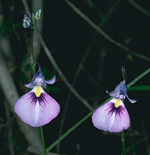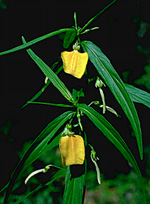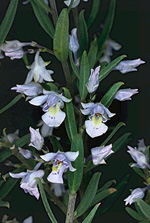 |
This is an almost cosmopolitan family, mainly of trees and shrubs in the
tropics, and of herbs (especially Viola) in temperate regions.
In Australia it is represented by 5 genera, of which Rinorea is
a tree of tropical rainforests, Hymenanthera a shrub from the south-east,
Hybanthus a widespread genus of herbs and subshrubs, mostly from
open areas, Viola a common genus of the temperate south-east and
Melicytus a Pacific genus with one species on Norfolk Island.
Characteristic features of the family Violaceae in Australia include: - herbs, shrubs and trees with alternate leaves
- flowers regular or zygomorphic, green, white, pink, orange, blue or violet, with 5 free sepals and petals, sometimes with a corolla-spur or pouch
- stamens 5, often joined into a ring around the ovary and style
- ovary superior with an unlobed or beak-shaped stigma, developing into a capsular fruit or berry
Description
Evergreen shrubs, rarely trees, or annual or perennial terrestrial herbs.
Perennating by rhizomes or crowns. Vegetative reproduction by rhizomes
or stolons. Stems unarmed, or rarely with thorns or spines arising from
the leaf axils; internodes terete or distinctly angular. Internal secretions
not obvious. Plants glabrous, or with simple, non-glandular, unicellular
hairs. Leaves alternate and spiral, or opposite, or apparently whorled,
cauline or all or mostly basal or both basal and cauline if herbs, petiolate,
subsessile or sessile. Stipules present, distinct and free from the petiole,
scale-like, or membranous, or green and leafy, persistent. Lamina simple,
symmetric, filiform, acicular, subulate, linear, lanceolate, ovate, elliptic,
oblanceolate, oblong, spathulate, flabellate, reniform or orbicular; base
cuneate, attenuate, rounded, truncate, cordate, hastate or sagittate;
margins entire, crenate, dentate, serrate or sinuate, ±flat; venation
pinnate, or apparently palmate, with the midrib conspicuous, and the tertiary
venation not reticulate; surfaces not punctate; herbaceous. Domatia absent
or consisting of hair tufts in the vein angles. Flowers bisexual, or rarely
with bisexual and either male or female flowers occurring together. Inflorescences
terminal or axillary, consisting of racemes, panicles, umbels or solitary
flowers. Bracts and bracteoles present. Pollination by insects. Flowers
odourless or fragrant, stalked. Floral disc present; nectaries present
on the stamens. Perianth regular or irregular, of 2 dissimilar whorls.
Calyx segments free, of 5 sepals, imbricate or open in bud, herbaceous;
base with wings or other appendages, or without appendages. Corolla segments
free, of 5 petals, alternating with the sepals, imbricate in bud, white,
yellow, pink, magenta, purple, violet, rarely orange, without contrasting
markings, or streaked, spotted, etc, membranous; claws present or absent;
lobes ±entire; base of anterior petal spurred or saccate. Fertile
stamens 5, opposite to the sepals, free of the corolla, free of the ovary
and style, distinct from each other, fused by their filaments into an
open or closed tube, or fused by their anthers, all ±equal. Anthers
dorsifixed or basifixed, not versatile, opening inwards by longitudinal
slits, 2-celled; with appendages absent or apical. Ovary superior and
sessile. Carpels 1 or 3–5, fused; ovary with 1 locule. Style terminal
or eccentric, flabellate, single and unbranched. Ovules 1–numerous, stalked;
placentation parietal. Fruit a dehiscent loculicidal or valvular capsule,
sometimes with explosive dehiscence, or a fleshy indehiscent berry; the
perianth on the maturing fruit deciduous, rotting or liquefying, or dry
and persistent. Disseminule micro-surface ±smooth, white, cream,
yellow, magenta, purple, violet, brown or black, glossy or dull. Seeds
2–numerous per fruit. Aril present or absent. Cotyledons 2. Embryo straight.
(Note: this description has been generated from the coded data compiled for the key. Any errors in the key data will be reflected in the descriptions.)
A treatment of the family Violaceae has been published in:
Flora of Australia 8: 91-110.
Australian genera of Violaceae (as recognised for the Flora of Australia)
† = some species native, others introduced
Hybanthus
Hymenanthera
Melicytus
Rinorea
†Viola

|
  |

Hybanthus calycinus (flowers)
Photo: M.Fagg © ANBG

Hybanthus enneaspermus (flowers)
Photo: M.Fagg © ANBG

Hybanthus enneaspermus ssp. stellarioides (flowers)
Photo: G.Leiper © G.Leiper

Hybanthus floribundus (flowers)
Photo: M.Fagg © ANBG

|
 |
|